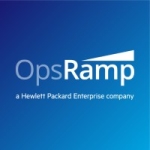What is most valuable?
As a total offering, Ops Bridge is a strong offering in the market. It adds value; it's competitive in its entirety, from network scanning to enrichment, up into event information. The implementation is challenging with customers, so we see added value, but there are diminished returns due to the complexity of the implementation and also the maintainability in general. There are some challenges, but overall there is added value.
How has it helped my organization?
For its fundamental proposition and as far as the way it works, it works well. It's a strong product; it has a wide capability - especially if you integrate it with more application performance-related solutions - and if you have infrastructure scanning, those two work together well. The data model and the data flow is pretty good, so overall it's a product that definitely adds value in a complex organization; complex in terms of infrastructure and application infrastructure. It's definitely a good product.
What do I think about the stability of the solution?
The application is stable; it's about when environmental changes impact what you do and how you look at it. Increasing the reach of the application adds additional work.
What do I think about the scalability of the solution?
When you look at it - for instance, in event detection – that’s when you want to understand how an application relates to the infrastructure, and how that works. There's some modelling involved; you need an understanding of how that application relates to the infrastructure. There's automation for that, but not everything can be captured. There's overlap between what different applications see in an infrastructure and how they report that back. To merge that information correctly, to make sure that you have the entire stack - the technology stack and application stack - properly configured, that requires attention, that requires configuration.
We worked with customers who want to manage critical applications. They have to map out the applications into the different infrastructure components; if it's mainframe related, for instance, which is still a big part of the picture, especially in the financial sector. They need to map the individual jobs and the alerting to an application, so that's a lot of manual work.
How are customer service and support?
Depending on where you land, if you get stuck in generic level-two support, then it’s quite uninspiring – that’s probably the best description. There's a high return of returning tickets back to the pending customer; getting tickets closed without adding value to the solution. Every step has one question. A ticket goes to a pending customer, you send a response immediately, and 24 hours later you receive the next update, which says something like, "Thanks, now we need this piece of information." The ticket then goes back to the pending customer, so you can easily lose a week just trying to get to a point where they're looking at your issue. Even if you set up a WebEx in which they look at what you're doing and understand the issue, we still go through the same process; there's additional information we request.
It's really tedious to get through that. When you switch to level-three or more of the ACE-type support, that goes away. In a discussion with HP, they typically say something like, "You should upgrade your support levels."; buy better support instead of actually maybe fixing their L1, L2 support. If you have the product and support is part of the license you buy, then I would expect to have a certain level of quality in that support, without having to upgrade to some kind of premium plan. It's not about having a dedicated comm tech, or someone who understands your environment, or all these additional things. It's actually about getting a proper response to a well-formulated question.
How was the initial setup?
For greenfield implementation, which still happens, fundamentally I think Ops Bridge provides a deeper level of understanding of what's going on in the infrastructure. If it's a complex environment, it's difficult to find toolsets that will address it correctly. If you look at the entire offering of Ops Bridge, it's one component in the suite that is relevant for monitoring your environment; detection of what's going in that environment.
If you look at Live and more holistically, all those components that include a BSM, OMi, and other products that I forget, that by itself offers multiple layers in the different technical areas of infrastructure. They work well together for some data modelling challenges, I guess, but overall it works well together and it provides a many-layered insight into what's going on in the infrastructure. You have different levels of how you can see what's going and analyze what you should be doing to address that.
Which other solutions did I evaluate?
In a complex environment, I don't think there are many good alternatives that offer it more or less end to end. You'd be cobbling different vendors, maybe with the exception of BMC, which probably could do it. The overall offering is consistent and as wide a technology as you can find, so there's strong benefits because you can do it all with a HP stack with augmentation of some of the specific domains with other vendors, which you have to do anyway.
I don't know if there’s any alternative. I think the main driver there would be how comfortable they are with the existing product suite. I think IBM is probably the strongest alternative in the field. I think they're behind, from a technology perspective. The only thing that they seem to be stronger with is related to the visualization.
At the Ops Bridge level – basically, at the highest level - how do I view my environment? What do I see going on? And, can I use that information in an aggregated way to prevent or limit the impact of occurrences of events in my environment? That's what Ops Bridge, or the OMi component, doesn't have to that level. You can't go from all the way to the top to all the way at the bottom to drill down, you have to use different environments for that. IBM does have that.
If that's important to have on there, then that's one of the things the people that manage the infrastructure need to be able to do. Especially if it's over multiple sites - a strong geographically dispersed environment - then they would be an alternative, but for all other situations, there isn't much else out there.
What other advice do I have?
As with anything, it's not just a tool and switching it on. They need to realize that it's a journey with a lot of challenges. Especially organizationally, it's not only about putting something in to existing systems; it’s also the desire to be compliant in organizational departments; it's invisibility of infrastructure because of security reasons or appliances that don't allow access. There's a lot of challenges organizationally that, even though you have the best software, you're still going to have to put a lot of effort in.
Overall advice is that if you do this, you need to commit and to be ready to put in a lot of effort in getting your organization to basically comply and help out. I think these products are really strong in terms of UI, but there's room for improvement in some of the usability and some of the integration components could be stronger.
Disclosure: My company has a business relationship with this vendor other than being a customer. We're partners.

















Thanx for valuable info about HP Operations Manager